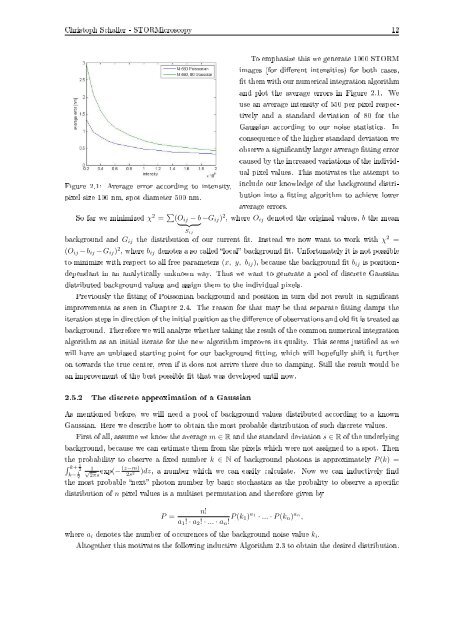Christoph Florian Schaller - FU Berlin, FB MI
Christoph Florian Schaller - FU Berlin, FB MI
Christoph Florian Schaller - FU Berlin, FB MI
Create successful ePaper yourself
Turn your PDF publications into a flip-book with our unique Google optimized e-Paper software.
<strong>Christoph</strong> <strong>Schaller</strong> - STORMicroscopy 12<br />
Figure 2.1: Average error according to intensity,<br />
pixel size 100 nm, spot diameter 500 nm.<br />
To emphasize this we generate 1000 STORM<br />
images (for dierent intensities) for both cases,<br />
t them with our numerical integration algorithm<br />
and plot the average errors in Figure 2.1. We<br />
use an average intensity of 550 per pixel respectively<br />
and a standard deviation of 80 for the<br />
Gaussian according to our noise statistics. In<br />
consequence of the higher standard deviation we<br />
observe a signicantly larger average tting error<br />
caused by the increased variations of the individual<br />
pixel values. This motivates the attempt to<br />
include our knowledge of the background distribution<br />
into a tting algorithm to achieve lower<br />
average errors.<br />
So far we minimized χ 2 = ∑ (O ij − b −G ij ) 2 , where O ij denoted the original values, b the mean<br />
} {{ }<br />
S ij<br />
background and G ij the distribution of our current t. Instead we now want to work with χ 2 =<br />
(O ij − b ij − G ij ) 2 , where b ij denotes a so called local background t. Unfortunately it is not possible<br />
to minimize with respect to all free parameters (x, y, b ij ), because the background t b ij is positiondependant<br />
in an analytically unknown way. Thus we want to generate a pool of discrete Gaussian<br />
distributed background values and assign them to the individual pixels.<br />
Previously the tting of Poissonian background and position in turn did not result in signicant<br />
improvements as seen in Chapter 2.4. The reason for that may be that separate tting damps the<br />
iteration steps in direction of the initial position as the dierence of observations and old t is treated as<br />
background. Therefore we will analyze whether taking the result of the common numerical integration<br />
algorithm as an initial iterate for the new algorithm improves its quality. This seems justied as we<br />
will have an unbiased starting point for our background tting, which will hopefully shift it further<br />
on towards the true center, even if it does not arrive there due to damping. Still the result would be<br />
an improvement of the best possible t that was developed until now.<br />
2.5.2 The discrete approximation of a Gaussian<br />
As mentioned before, we will need a pool of background values distributed according to a known<br />
Gaussian. Here we describe how to obtain the most probable distribution of such discrete values.<br />
First of all, assume we know the average m ∈ R and the standard deviation s ∈ R of the underlying<br />
background, because we can estimate them from the pixels which were not assigned to a spot. Then<br />
the probability to observe a xed number k ∈ N of background photons is approximately P (k) =<br />
´ k+ 1<br />
2<br />
k− 1 2<br />
√ 1<br />
2πs<br />
exp(− (z−m)<br />
2s<br />
)dz, a number which we can easily calculate. Now we can inductively nd<br />
2<br />
the most probable next photon number by basic stochastics as the probality to observe a specic<br />
distribution of n pixel values is a multiset permutation and therefore given by<br />
P =<br />
n!<br />
a 1 ! · a 2 ! · ... · a n ! P (k 1) a1 · ... · P (k n ) an ,<br />
where a i denotes the number of occurences of the background noise value k i .<br />
Altogether this motivates the following inductive Algorithm 2.3 to obtain the desired distribution.









